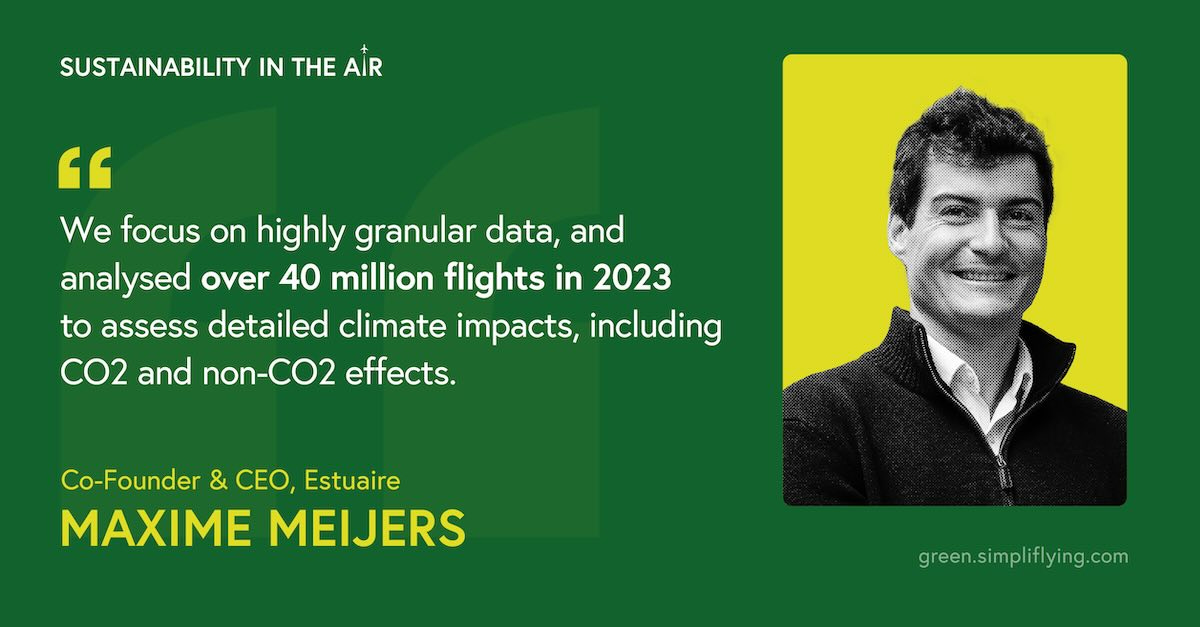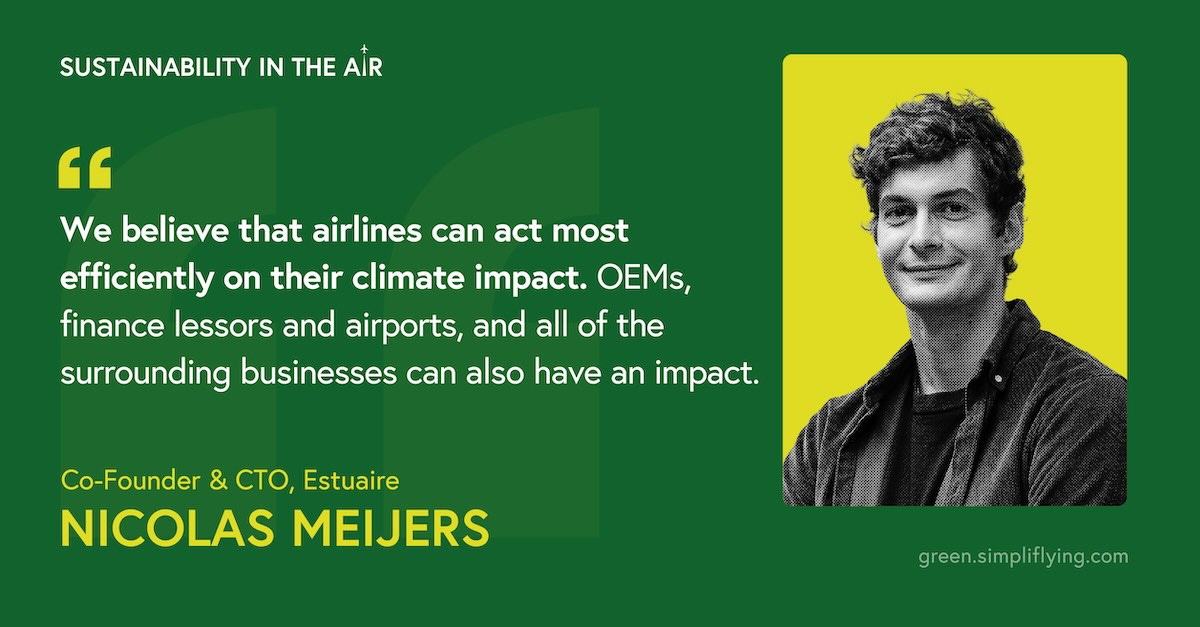In the 100th episode of our 'Sustainability in the Air' podcast, Shashank Nigam, CEO of SimpliFlying, speaks with Maxime Meijers and Nicolas Meijers, co-founders of Estuaire, a French aviation and climate data platform.
The brothers share insights into their innovative technology and its potential to revolutionise the assessment and reduction of aviation's climate impact, with a focus on non-CO2 impacts.
Here are the key highlights of the conversation:
Understanding aviation’s non-CO2 impacts and Estuaire’s technology (4:15)
Estuaire’s data-driven approach to climate impact assessment (7:14)
The surprising impact of contrails and targeted interventions (17:57)
Strategic partnerships and ecosystem approach (35:26)
Future goals and scaling up operations (47:55)
Rapid Fire! (42:41)
Keep reading for a quick overview of the episode.
The importance of understanding aviation’s non-CO2 emissions
Recent studies have highlighted the significant climate impact of aviation's non-CO2 emissions, particularly contrails. Contrails, which form when water vapour condenses around aircraft exhaust particles, can persist as cirrus clouds and trap heat in the atmosphere. A recent IPCC report noted that contrail-induced clouds account for roughly 35% of aviation's global warming impact.
Understanding this impact is now serious business.
Google, American Airlines, and Breakthrough Energy collaborated on a project using AI and satellite imagery to predict and avoid contrail-forming regions, reducing contrail length by 54% in test flights.
NASA has partnered with Boeing and others to study how sustainable aviation fuels (SAF) and advanced engine technology can decrease contrail formation.
Airbus's ECLIF3 study found that using 100% SAF reduced the number of contrail ice crystals by 56% compared to conventional jet fuel, potentially decreasing contrails' climate-warming effect by at least 26%.
Importantly, in a growing sign of their importance, new EU rules require airlines to report both carbon dioxide emissions and the estimated climate impact of contrails to the European Commission annually.
Why Estuaire’s “granular data” matters for the future of sustainable aviation
As the aviation industry grapples with these new realities in addition to its carbon impact, new approaches are emerging to tackle the challenge. Estuaire, for instance, focuses on the power of granular data to drive meaningful change.
Their data platform goes beyond traditional carbon calculators, offering a comprehensive view of an airline’s climate impact. This granular approach allows for a level of detail and accuracy that can lead to more effective interventions and strategies for reducing aviation’s environmental footprint.
By analysing individual flights, their trajectories, weather conditions, and other relevant factors, Estuaire can offer insights that would be impossible with more generalised data. This level of detail is crucial for identifying the most effective areas for intervention and optimising flight operations for minimal environmental impact.
Five ways Estuaire’s data platform can make a difference
1. Comprehensive climate impact modelling
One of the key differentiators of Estuaire’s approach is its focus on comprehensive climate impact modelling. While many existing solutions focus solely on CO2 emissions, Estuaire takes into account a broader range of factors, including non-CO2 effects such as contrails.
Nicolas highlights the importance of this approach: “There is a famous paper from David Lee that dates back from 2019 that suggests that these non-CO2 effects are potentially as important as the CO2 effect itself.”
By incorporating these additional factors into their modelling, Estuaire provides a more accurate picture of aviation’s true climate impact, allowing aviation brands to make more informed decisions about their operations.
2. Data fusion and transparency
Central to Estuaire’s approach is the concept of data fusion – combining multiple data sources to create a more complete picture.
“The end vision of the company is to be able to leverage as many sources as possible, both open source data and private data,” Nicolas explains.
This approach allows Estuaire to overcome the limitations of individual data sources. For example, they combine flight trajectory data, weather information, fuel burn estimates, and other relevant factors to create a comprehensive view of each flight’s climate impact.
Maxime emphasises the unique transparency of the aviation sector, which allows for a level of data gathering and analysis that would be impossible in many other industries:
“Aviation, [like] shipping, because it’s regulated, has this unique transparency. Any flight can be tracked on a mobile application.”
3. Targeted interventions for maximum impact
One of the most interesting insights from Estuaire’s work is the potential for targeted interventions to have a disproportionate impact on reducing aviation's climate footprint.
Research has shown that “only 2% of the flights are responsible for 80% of aviation’s contrail warming effect.”
Maxime explains further, “You work on those [2%] flights… You change the route, you load a little bit more SAF onto them, and at a very cheap cost, you can have massive climate savings, which are actually colder temperatures on ground.”
This approach can allow airlines to achieve significant reductions in their climate impact without the need for widespread, costly changes to their operations. It’s a great example of how granular data can lead to more effective sustainability strategies.
4. Ecosystem approach and benchmarking
While airlines are the primary focus of Estuaire’s work, their approach recognises the interconnected nature of the aviation industry, which functions together as an ecosystem.
This ecosystem approach allows for a more comprehensive way to reduce aviation's climate impact. For example, airports can use Estuaire’s data to implement climate-driven airport charges or optimise SAF distribution, indirectly influencing airline behaviour.
In addition, Estuaire’s platform allows for benchmarking against competitors, providing context for an airline’s climate performance.
As Nicolas explains: “Let’s say you’re on American Airlines. You want to know your contrails. Not only can you know your contrail impacts, but you can also look at the contrail impact of Delta or United and say, okay, am I generating more contrails than my competitors?”
5. Balancing present focus with future vision
While Estuaire’s work is grounded in present-day operations and data, the company wants to also focus on the future of aviation and climate change.
Maxime notes that they're working towards a future where at least “10 extremely large airlines have successfully implemented a contrail mitigation program. And day to day, they know where contrails form. They try to avoid them.”
They also emphasise the immediate potential for impact:
“[Contrail mitigation is something you] can do today. You don’t have to wait for SAF supply to scale up. You don’t have to wait for a new fuel like hydrogen or electric planes.”
This balance between addressing immediate opportunities and preparing for long-term challenges is crucial in sustainable aviation. As aviation continues to grapple with its environmental impact, approaches like Estuaire’s will be crucial in charting a course towards a more sustainable future.
‘Sustainability in the Air’ is the world’s leading podcast dedicated to sustainable aviation. Through in-depth conversations with top aviation leaders, we break through the clutter and provide a clear roadmap for a net-zero future.
















